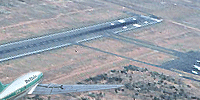 |
 |
|
||||
|
By
Wikipedia,
The PZL Kania (Polish Kitty Hawk) is a follow-up to the Mil Mi-2. Design and developmentThe Kania is a helicopter featuring many changes. It has a redesigned hull, new engines (Rolls-Royce Allison 250-C20B turboshaft engines) each rated at 426hp (313 kW), new composite rotors blades, and new western avionics. Work on the version was started in 1969 and the first prototype was flown on 3 June 1979. Tests conducted during the early 1980s led to certification according to FAR-29, in February 1986. The helicopter is produced in small numbers (also as an upgrade to the original Mi-2) in Poland, in the PZL Świdnik factory. Variants
OperatorsSpecificationsGeneral characteristics
Performance
See alsoRelated development
Text from Wikipedia is available under the Creative Commons Attribution/Share-Alike License; additional terms may apply.
Published in July 2009. Click here to read more articles related to aviation and space!
|
||||||||||||||||||||||||||||||||||||||||||||||||||

 |
|
Copyright 2004-2025 © by Airports-Worldwide.com, Vyshenskoho st. 36, Lviv 79010, Ukraine Legal Disclaimer |